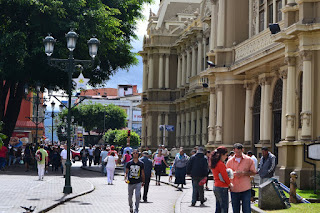The capital doesn't have high rise buildings or much left of the colonial era. Yet, there is a lot of nice architecture to see, if one knows where to look for it.
In the last week of December, there are festivities and events for Josefinos (people from San Jose) to celebrate the end and beginning of the year, mainly the Tope and the municipal festivities in Zapote.
A good concentration of points of interest in San Jose is found on and around the Central Avenue Boulevard. I walked the entire region from Iglesia de la Merced to Barrio Amon. Next day, I went to the Tope, one of the most popular events in San Jose at the end of the year, featuring horses from all over the country. Walking down the street and taking pictures of the people, I realized my half-brother was in one of them, and so I spent most of the time with him and his gung (in fact, the Barra Morada - Saprissa Die Hard soccer fans!).
Central Avenue Boulevard
Barrio Amon
San Jose doesn't have much left of the colonial era, but some can still be found in this upscale neigborhood. Decades ago, rich families lived in large mansions here that featured architecture from colonial times. Today, most of the nicest buildings are now hotels, restaurants and art galleries or government offices. A few blocks away from the busy and commercial Avenida Central, Barrio Amon is a quite residential area characterised by hills, bohemian and artsy scenes, and interesting architecture.
Tope de San Jose
The end-of-the-year horse parade usually takes place on the Sunday before new year's eve, and marks the beginning of the municipal festivities in Zapote. According to La Nacion, a major newspaper, this year there was a record number of horse riders, with more than 4,000 compared to around 2,000 last year. The ambient is always exicinting and fun. Families and groups of friends put on their cowboy huts and set mini-bars and pic-nic tables on the street, and some even bring sofas! Also, there are the famous "Cimarronas" - groups of musicians that play at town festivities. In all, this is a fun activity to relax and have a good laugh with beer.
Toros a la Tica
Zapote, San Jose
Bull-fighting Tico style is an all time favorite. Hundreds of improvised bull fighters tease the bull in the "Redondel". Some of them put on customes like Superman, Batman, clowns, etc. Unlike in other countries, the bull is not killed, and instead, many get badly hurt, and some even killed. There is also the "Monta de Toros" which is to ride the bull, similar to how Texans do it but in the Tico style. This year, there were presentations by international bull riders, including Texans, South and Central Americans in the December festivities in San Jose.
The "Toros" also have funny moments, like last week in Zapote when a bull undressed almost completly a guy - and he got paid $50 for that! Check out the first 30 seconds of the youtube video. Another video with improvised bull fighting in Santa Cruz coming up.
The Food, The Food!!!
Gifts and festitivities at the end of the year are nice.... but the food makes everything even nicer! Traditionally, Ticos prepare "tamales" only in December, so imagine how much happiness there is around after waiting for 11 months! Some people like to eat them with coffee and others with "agua dulce" for either meal of the day. Another tradition is to have two dinners, one on the 24th at the regular dinner time and the other one on the 31st at midnight, although not everyone likes to wait.
The festivities at the end and beginning of the year offer a good opportunity to see how Ticos like to eat and celebrate. In January, there are some more festivities in other parts of the country outside of San Jose. The two most anticipated (by account of many and the adversiting on TV) are the "Fiestas de Palmares, Alajuela" and the "Fiestas de Santa Cruz, Guanacaste". Going to these festivities in Palmares and Santa Cruz is already a tradition for many. They feature dance halls, tent bars, fireworks, lots of foods, contests, and the beloved Tope and bull fighting Tico style.
Both events are good in their own right. Palmares has a mix of country side and city life, and since I have memory the festivities here have always been regarded as one of the biggest and most exciting events that include concert presentations by international and national artists. In regards to Santa Cruz, life here is very traditional and one of Guanacaste's most important towns. Aside from that, Guanacaste is considered the cradle of Costa Rican traditions. And.... people here are known for partying hard, from sunset to sunrise - for five months in different towns!
This year, these two festivities fall on the same dates on the week of the 14th, so I am gonna have to do miracles to assist to both.
Photo albums this week




No comments:
Post a Comment